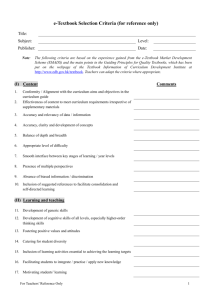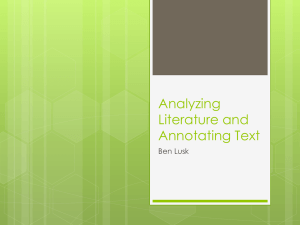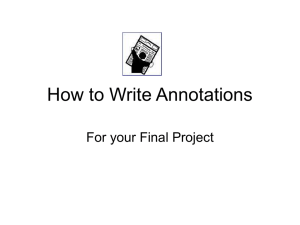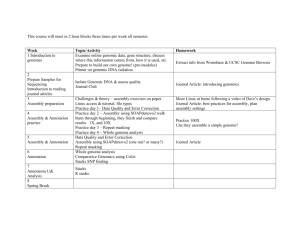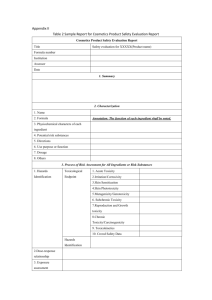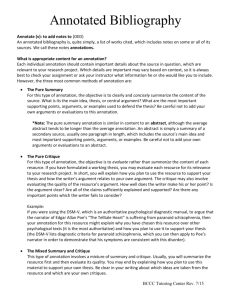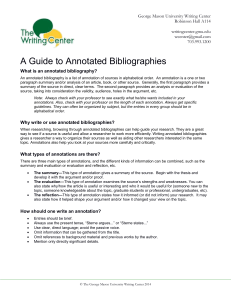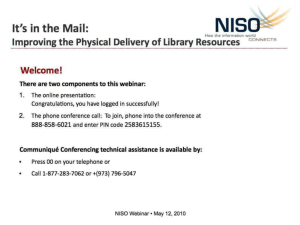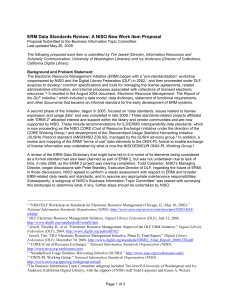A Proposed NISO Work Item
advertisement
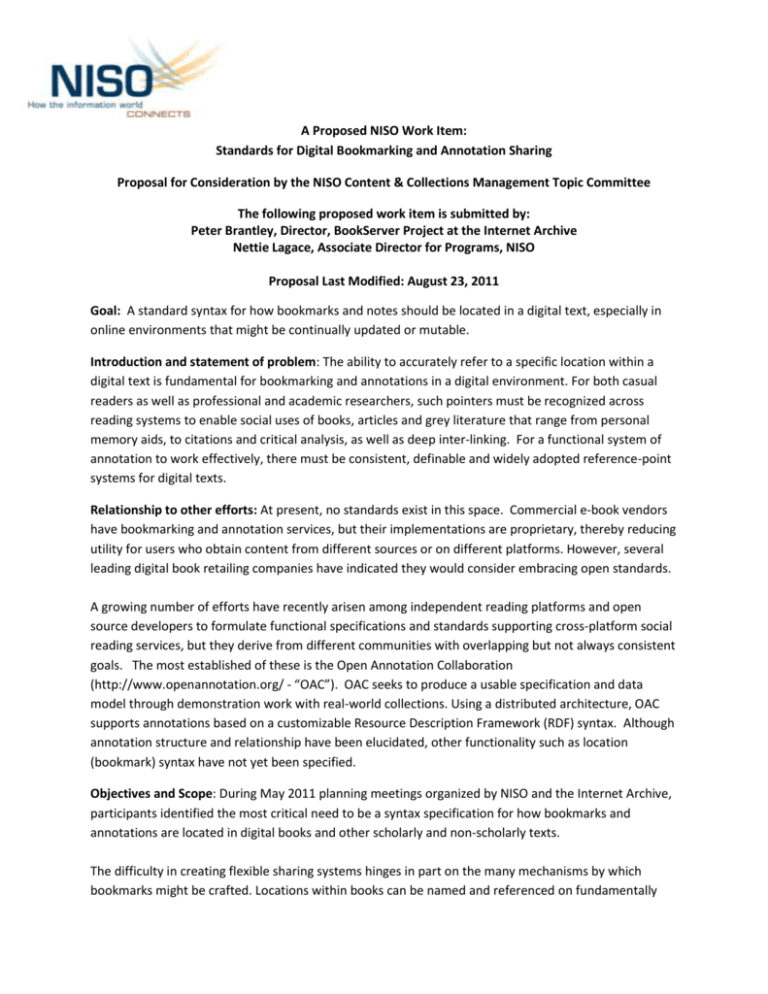
A Proposed NISO Work Item: Standards for Digital Bookmarking and Annotation Sharing Proposal for Consideration by the NISO Content & Collections Management Topic Committee The following proposed work item is submitted by: Peter Brantley, Director, BookServer Project at the Internet Archive Nettie Lagace, Associate Director for Programs, NISO Proposal Last Modified: August 23, 2011 Goal: A standard syntax for how bookmarks and notes should be located in a digital text, especially in online environments that might be continually updated or mutable. Introduction and statement of problem: The ability to accurately refer to a specific location within a digital text is fundamental for bookmarking and annotations in a digital environment. For both casual readers as well as professional and academic researchers, such pointers must be recognized across reading systems to enable social uses of books, articles and grey literature that range from personal memory aids, to citations and critical analysis, as well as deep inter-linking. For a functional system of annotation to work effectively, there must be consistent, definable and widely adopted reference-point systems for digital texts. Relationship to other efforts: At present, no standards exist in this space. Commercial e-book vendors have bookmarking and annotation services, but their implementations are proprietary, thereby reducing utility for users who obtain content from different sources or on different platforms. However, several leading digital book retailing companies have indicated they would consider embracing open standards. A growing number of efforts have recently arisen among independent reading platforms and open source developers to formulate functional specifications and standards supporting cross-platform social reading services, but they derive from different communities with overlapping but not always consistent goals. The most established of these is the Open Annotation Collaboration (http://www.openannotation.org/ - “OAC”). OAC seeks to produce a usable specification and data model through demonstration work with real-world collections. Using a distributed architecture, OAC supports annotations based on a customizable Resource Description Framework (RDF) syntax. Although annotation structure and relationship have been elucidated, other functionality such as location (bookmark) syntax have not yet been specified. Objectives and Scope: During May 2011 planning meetings organized by NISO and the Internet Archive, participants identified the most critical need to be a syntax specification for how bookmarks and annotations are located in digital books and other scholarly and non-scholarly texts. The difficulty in creating flexible sharing systems hinges in part on the many mechanisms by which bookmarks might be crafted. Locations within books can be named and referenced on fundamentally different types of frameworks: technical, such as byte offsets; structural, such as chapter/ paragraph/ sentence; or epistolary, such as the entrance of a leading character. This syntax should be tested in relation to real-world applications either in launched or in development. Proof of concept models such as those developed by OAC can present some workable frameworks, but real-world implementations and product development such as work underway by Barnes & Noble provides constraints on these proofing models, showing that when they are applied to different content and new publication formats across a varied customer base, including libraries, they may not work as originally designed. In addition, intellectual property concerns of content providers must be considered. For example, publishers are wary of connecting annotations to particular text passages, as it may be possible to recreate the entire text through annotations, bypassing any content protection measures. Audience: The potential audience for such a standard is broad, impacting nearly all sectors of online publishing. A standard would be a major element of any major digital book or text distribution platform, such as Amazon’s Kindle, Barnes & Noble’s nook, Apple’s iBook or other providers of platforms for scholarly texts. Annotation portability is the cornerstone of a large number of social reading experiences, and many media commentary services. Most directly, a standard would enhance the experience of digital book readers interested in bookmarking and annotation support. This standard could also be adopted by scholarly journal publishers and any other party interested in such specific citeability and sharing. Stakeholders: The International Digital Publishing Forum (IDPF), an international standards body that created and manages EPUB, the most widely implemented digital book format, has a significant interest in bookmarking and document inter-linking. It has held discussions within its technical working groups concerning the development of a bookmarking standard. IDPF has an active relationship with NISO consequent to discussions over EPUB’s place in the international standards community, and it has indicated willingness to support an external standard on bookmarking and annotation. Other stakeholders include digital book retailers such as Amazon, Kobo, Google, and Barnes & Noble; a wide variety of independent not-for-profit and academic contributors, and a number of startups or stealth efforts at either newly emerging or established companies seeking to provide social reading or digital media annotation services. Work timeline: Formation of a standards Working Group in early fall will permit discussions to commence leading up to two meetings in October, supported by the Andrew W. Mellon Foundation, that will bring together representatives of leading stakeholder organizations. These meetings will further refine scope and objectives of the working group, leading to draft standards consensus. The resulting standard will be developed during late 2011 and the first part of 2012, with a preliminary goal of publication by late 2012 after a public review phase. If possible, the NISO Working Group will also produce a set of practice guidelines to help parties implement the syntax. Adoption/Marketing: The announcement of a NISO Working Group will be accompanied by a press release widely distributed among international industry reporters in publishing, new media, and the public and research library communities. In addition, the two October 2011 planning meetings will catalyze industry attention, broaden the participant community, and promote the issue and the development of standards for the location and sharing of reference and annotation information. Industry press will be included as part of these efforts, and standards efforts endorsement and any adoption by prominent commercial digital text vendors will be coordinated with NISO to ensure optimal press coverage.

